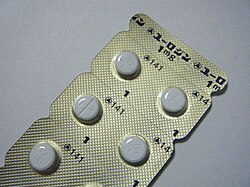 | |
 | |
| Clinical data | |
|---|---|
| Trade names | Prosom, Esilgan, Eurodin, Nuctalon, others |
| Other names | Desmethylalprazolam |
| AHFS/Drugs.com | Monograph |
| MedlinePlus | a691003 |
| License data | |
| Routes of administration | By mouth |
| ATC code | |
| Legal status | |
| Legal status |
|
| Pharmacokinetic data | |
| Bioavailability | 93% |
| Metabolism | Liver |
| Elimination half-life | 10–24 hours |
| Excretion | Kidney |
| Identifiers | |
| |
| CAS Number | |
| PubChem CID | |
| IUPHAR/BPS | |
| DrugBank | |
| ChemSpider | |
| UNII | |
| KEGG | |
| ChEBI | |
| ChEMBL | |
| CompTox Dashboard (EPA) | |
| ECHA InfoCard | 100.045.424 |
| Chemical and physical data | |
| Formula | C16H11ClN4 |
| Molar mass | 294.74 g·mol−1 |
| 3D model (JSmol) | |
| |
| |
| (verify) | |
Estazolam, sold under the brand name Prosom among others, is a tranquilizer medication of the triazolobenzodiazepine (TBZD) class, which are benzodiazepines (BZDs) fused with a triazole ring. It possesses anxiolytic, anticonvulsant, hypnotic, sedative and skeletal muscle relaxant properties. Estazolam is an intermediate-acting oral benzodiazepine. It is used for short-term treatment of insomnia.
Contents
- Medical uses
- Side effects
- Tolerance and dependence
- Contraindications and special caution
- Pharmacology
- Pharmacokinetics
- Interactions
- EEG effects in rabbits
- Abuse
- See also
- References
- External links
It was patented in 1968 and came into medical use in 1975. [3]
